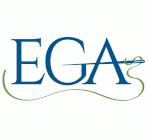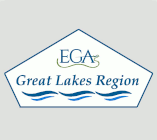 |
Needle Arts Guild of ToledoA member Chapter of the Great Lakes Regionof The Embroiderers' Guild of America, Inc.. |
 |
|
|
Evaluating Your Embroidery - Suitability of MaterialsThe following article was written by Cathy Studer in 2004 for the newsletter
of the Needle Arts Guild of Toledo. After choosing your design the next step in creating a successful embroidery is the purchase of materials. One of the first things to remember is that you will get what you pay for! Many hours are spent stitching our projects, it would be senseless to use inferior materials that will not hold up. For lasting quality, purchase the best materials that you can afford. Do not purchase ground materials that have an obvious crease in them. These creases tend to pick up dirt marks and are very difficult to remove. It would be a shame to have a permanent crease running down the middle of a carefully stitched embroidery. Also be wary of dirt marks anywhere on the ground material, maybe it will wash out, but maybe it won't. If the item you are stitching will be washed regularly, such as clothing or linens, it is important to use materials that are strong and colorfast. Linen and cotton are the best materials to use in this case. Wools can be washed in cold water and air dried. Rayon will permanently wrinkle when wet and must be dry cleaned. For most other threads dry cleaning is also the preferred method if cleaning is necessary. Washing canvas will remove sizing and can make it more difficult to stitch without distortion. However, this may be desirable if you are working a pulled thread design on canvas. Be careful of exposing congress cloth to water, some congress cloth will develop water spots. Plastic canvas will dissolve if dry cleaned and must be washed only. For items that will be washed you will first want to pre-wash your ground fabric and test your threads for colorfastness. To do this, wet a paper towel, lay a short length of your thread on the towel and fold the towel over. You can lay several threads on each paper towel as long as there is space between. Let this dry completely. If there is the slightest discoloration on the paper towel after it is dry, your thread is not colorfast. If this happens, take your thread and soak in cool water, rinse and soak again, repeating this until your water is clear. Re-test your thread with the paper towel. Remember that darker colors tend to bleed more. All washing of embroidered items should be done by hand not by machine. If you are working a design that has several pieces, such as an article of clothing or a large tablecloth, be sure you buy fabric that is cut from the same bolt to prevent the slight differences that can be found in count and dye lot. Also be sure to mark the top and the bottom of the fabric so that all stitching will be worked in the same direction. Fabrics sometimes vary slightly in vertical and horizontal thread counts which can throw off the dimensions of a final piece. Also be sure for any stitching project that when purchasing threads you buy enough and perhaps a bit more than needed of the same dye lot to prevent any differences in color. When stitching dark colors on a white or light colored ground fabric sometimes undesirable flecks of white will show through. You can prevent this by coloring these areas before stitching with thinned acrylic paints or acid free permanent markers. Wet test this first on a sample of ground fabric for colorfastness. If your embroidery is fairly dark you may want to consider using a colored ground fabric. Aida cloth is a common ground for working cross stitch, assisi and blackwork. You may wish to consider using linen or one of the other fabrics available for this type of work. If so, it is best to use a solidly woven ground. This will prevent a shifting of the stitches while handling or washing. The threads or strand count for these techniques are dependent upon the look you wish to achieve. Use less strands or a finer thread for an open look, a thicker thread or more strands for full coverage, or an even thicker thread for a slight dimensional effect. Hardanger fabric can be used for working this type of embroidery, but so can linens and the other fabrics woven for counted work. It is important for this ground to be tightly woven. Kloster blocks work as an overcasting stitch to prevent cut edges from unraveling. This along with stretching or distortion could become a problem with a fabric that has a loose weave. When stitching kloster blocks you will want to use a thread thick enough for the stitches to lie next to each other with no fabric showing between. For filling stitches a finer thread is used. Stranded cottons are not the best choice for this type of work. Pearl cottons are normally used. When working pulled thread it is best to use a counted fabric with an open weave. The pulling of the ground fabric threads creates the lacy patterns that is characteristic of this type of embroidery. With an open weave the distortion of the ground fabric becomes easier and enhances the lacy effect. It is important to use a strong thread so it does not break when pulling the stitches. You also want to use a thin thread so as not to detract from the patterns created by the pulling. A good rule of thumb is to use a thread that is the same thickness as a thread from the ground fabric. Because threads are withdrawn when working drawn thread, either a close or open weave ground fabric will work. Threads used would generally be the same as for pulled thread work. When working on canvas the use of the finished item must be taken into consideration. When working items like chair seats, rugs and pillows, tapestry wool is tightly twisted and will wear well. Persian wool is not twisted as tightly, it will hold up, but not as well as tapestry wool. Crewel wool has the loosest twist and should not be used for items that will take a lot of wear. For decorative items and hanging pieces the choices are endless. Be sure when choosing your threads, or any attached objects, that they enhance and are a meaningful part of the design. Simplicity is best, it is very easy to over-do by putting in every type of thread we can find into one embroidery. This also holds true for surface stitchery. Be sure when choosing the ground fabric for your surface stitchery that it will be a sturdy base for your embroidery. The use of too light of a ground fabric will cause puckering in the final stitched piece. Embroideries such as shadow stitching and French handsewing are delicate and use fine ground fabrics and thin threads. Metal threads require a heavier ground fabric to support the weight of the metals. Linen twill is an excellent choice for crewel embroideries. These are just basic guidelines in choosing materials. I do suggest that whatever type of embroidery you enjoy working that you purchase a good book that describes fabrics and threads that are most appropriate. Don't forget to check out the books that we have in our own library also. This page was last updated on September 24, 2018. |
|